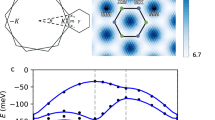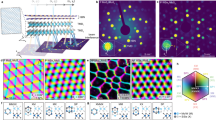Abstract
Van der Waals heterostructures form a unique class of layered artificial solids in which physical properties can be manipulated through controlled composition, order and relative rotation of adjacent atomic planes. Here we use atomic-resolution transmission electron microscopy to reveal the lattice reconstruction in twisted bilayers of the transition metal dichalcogenides, MoS2 and WS2. For twisted 3R bilayers, a tessellated pattern of mirror-reflected triangular 3R domains emerges, separated by a network of partial dislocations for twist angles θ < 2°. The electronic properties of these 3R domains, featuring layer-polarized conduction-band states caused by lack of both inversion and mirror symmetry, appear to be qualitatively different from those of 2H transition metal dichalcogenides. For twisted 2H bilayers, stable 2H domains dominate, with nuclei of a second metastable phase. This appears as a kagome-like pattern at θ ≈ 2°, transitioning at θ → 0 to a hexagonal array of screw dislocations separating large-area 2H domains. Tunnelling measurements show that such reconstruction creates strong piezoelectric textures, opening a new avenue for engineering of 2D material properties.
This is a preview of subscription content, access via your institution
Access options
Access Nature and 54 other Nature Portfolio journals
Get Nature+, our best-value online-access subscription
$29.99 / 30 days
cancel any time
Subscribe to this journal
Receive 12 print issues and online access
$259.00 per year
only $21.58 per issue
Buy this article
- Purchase on Springer Link
- Instant access to full article PDF
Prices may be subject to local taxes which are calculated during checkout




Similar content being viewed by others
Data availability
Additional data related to this paper is available from the corresponding authors upon reasonable request.
Code availability
The computer code used for the image filtering is available from the corresponding authors upon reasonable request.
References
Ponomarenko, L. A. et al. Cloning of Dirac fermions in graphene superlattices. Nature 497, 594–597 (2013).
Dean, C. R. et al. Hofstadter’s butterfly and the fractal quantum Hall effect in moiré superlattices. Nature 497, 598–602 (2013).
Cao, Y. et al. Unconventional superconductivity in magic-angle graphene superlattices. Nature 556, 43–50 (2018).
Cao, Y. et al. Correlated insulator behaviour at half-filling in magic-angle graphene superlattices. Nature 556, 80–84 (2018).
Yin, L. J., Jiang, H., Qiao, J. B. & He, L. Direct imaging of topological edge states at a bilayer graphene domain wall. Nat. Commun. 7, 1–6 (2016).
Huang, S. et al. Topologically protected helical states in minimally twisted bilayer graphene. Phys. Rev. Lett. 121, 37702 (2018).
Seyler, K. L. et al. Signatures of moiré-trapped valley excitons in MoSe2/WSe2 heterobilayers. Nature 567, 66–70 (2019).
Tran, K. et al. Evidence for moiré excitons in van der Waals heterostructures. Nature 567, 71–75 (2019).
Jin, C. et al. Observation of moiré excitons in WSe2/WS2 heterostructure superlattices. Nature 567, 76–80 (2019).
Alexeev, E. M. et al. Resonantly hybridized excitons in moiré superlattices in van der Waals heterostructures. Nature 567, 81–86 (2019).
Woods, C. R. et al. Commensurate–incommensurate transition in graphene on hexagonal boron nitride. Nat. Phys. 10, 451–456 (2014).
Yoo, H. et al. Atomic and electronic reconstruction at the van der Waals interface in twisted bilayer graphene. Nat. Mater. 18, 448–453 (2019).
Alden, J. S. et al. Strain solitons and topological defects in bilayer graphene. Proc. Natl Acad. Sci. USA 110, 11256–11260 (2013).
Zhang, K. & Tadmor, E. B. Structural and electron diffraction scaling of twisted graphene bilayers. J. Mech. Phys. Solids 112, 225–238 (2018).
Butz, B. et al. Dislocations in bilayer graphene. Nature 505, 533–537 (2014).
Naik, M. H., Maity, I., Maity, P. K. & Jain, M. Kolmogorov–Crespi potential for multilayer transition-metal dichalcogenides: capturing structural transformations in moiré superlattices. J. Phys. Chem. C 123, 9770–9778 (2019).
Naik, M. H. & Jain, M. Ultraflatbands and shear solitons in moiré patterns of twisted bilayer transition metal dichalcogenides. Phys. Rev. Lett. 121, 266401 (2018).
Carr, S. et al. Relaxation and domain formation in incommensurate two-dimensional heterostructures. Phys. Rev. B 98, 224102 (2018).
Suzuki, R. et al. Valley-dependent spin polarization in bulk MoS2 with broken inversion symmetry. Nat. Nanotechnol. 9, 611–617 (2014).
Ubrig, N. et al. Microscopic origin of the valley Hall effect in transition metal dichalcogenides revealed by wavelength-dependent mapping. Nano Lett. 17, 5719–5725 (2017).
Kim, K. et al. Van der Waals heterostructures with high accuracy rotational alignment. Nano Lett. 16, 1989–1995 (2016).
Enaldiev, V. V., Zólyomi, V., Yelgel, C., Magorrian, S. J. & Fal’ko, V. I. Stacking domains and dislocation networks in marginally twisted bilayers of transition metal dichalcogenides. Preprint at https://arxiv.org/abs/1911.12804 (2019).
Zhu, H. et al. Observation of piezoelectricity in free-standing monolayer MoS2. Nat. Nanotechnol. 10, 151–155 (2015).
Duerloo, K. A. N., Ong, M. T. & Reed, E. J. Intrinsic piezoelectricity in two-dimensional materials. J. Phys. Chem. Lett. 3, 2871–2876 (2012).
Iordanskii, S. & Koshelev, A. Dislocations and localization effects in multivalley conductors. JETP Lett. 41, 574 (1985).
Rostami, H., Roldán, R., Cappelluti, E., Asgari, R. & Guinea, F. Theory of strain in single-layer transition metal dichalcogenides. Phys. Rev. B 92, 195402 (2015).
Koch, C. T. Determination of Core Structure Periodicity and Point Defect Density Along Dislocations. PhD thesis, Arizona State Univ. (2002).
Salmon, J., Harmany, Z., Deledalle, C.-A. & Willett, R. Poisson noise reduction with non-local PCA. J. Math. Imaging Vis. 48, 279–294 (2014).
Giannozzi, P. et al. Quantum Espresso: a modular and open-source software project for quantum simulations of materials. J. Phys. Cond. Mat. 21, 395502 (2009).
Kresse, G. & Furthmüller, J. Efficient iterative schemes for ab initio total-energy calculations using a plane-wave basis set. Phys. Rev. B 54, 11169–11186 (1996).
Schutte, W., Boer, J. D. & Jellinek, F. Crystal structures of tungsten disulfide and diselenide. J. Solid State Chem. 70, 207–209 (1987).
Nečas, D. & Klapetek, P. Gwyddion: an open-source software for SPM data analysis. Cent. Eur. J. Phys. 10, 181–188 (2012).
Acknowledgements
We acknowledge support from the Engineering and Physical Sciences Research Council (EPSRC) grants EP/N010345/1, EP/P009050/1, EP/S019367/1, EP/S030719/1, EP/P01139X/1, EP/R513374/1 and the Centre for Doctoral Training (CDT) Graphene-NOWNANO, and the EPSRC Doctoral Prize Fellowship. We also acknowledge support from the European Graphene Flagship Project, European Quantum Technology Flagship Project 2D-SIPC (820378), European Research Council (ERC) Synergy Grant Hetero2D, ERC Starter grant EvoluTEM (715502), Royal Society and Lloyd Register Foundation Nanotechnology grant. V.E. (reconstruction simulations) acknowledges the support of the Russian Science Foundation (project no. 16-12-10411). P.H.B. acknowledges support from the Leverhulme Trust (Research Fellowship grant RF-2019-460). We thank Diamond Light Source for access and support in use of the electron Physical Science Imaging Centre (Instrument E02 and proposal numbers EM19315 and MG21597) that contributed to the results presented here.
Author information
Authors and Affiliations
Contributions
V.I.F., S.J.H. and R.G. conceived the study. A.W. fabricated samples for TEM and cAFM. S.J.H., Y.Z. and N.C. performed TEM measurements. D.H. performed TEM simulations. N.C. processed the TEM data. N.C. and M.Z. provided custom TEM grids. V.E., V.Z., S.M., C.Y and V.I.F. provided DFT and multicale modelling and interpretation of the observations. A.S. and A.W. performed cAFM measurements with the help of T.H.B. and P.H.B. A.W. and J.Z. fabricated ARPES samples. A.G., A.B. and N.R.W. performed ARPES measurements. R.G., V.I.F., S.J.H. and A.W. wrote the manuscript. All authors contributed to the discussions and commented on the manuscript.
Corresponding authors
Ethics declarations
Competing interests
The authors declare no competing interests.
Additional information
Peer review information Nature Nanotechnology thanks Sergei Kalinin and the other, anonymous, reviewer(s) for their contribution to the peer review of this work.
Publisher’s note Springer Nature remains neutral with regard to jurisdictional claims in published maps and institutional affiliations.
Supplementary information
Supplementary Information
Supplementary Information, Figs. 1–21 and refs. 1–19.
Rights and permissions
About this article
Cite this article
Weston, A., Zou, Y., Enaldiev, V. et al. Atomic reconstruction in twisted bilayers of transition metal dichalcogenides. Nat. Nanotechnol. 15, 592–597 (2020). https://doi.org/10.1038/s41565-020-0682-9
Received:
Accepted:
Published:
Issue Date:
DOI: https://doi.org/10.1038/s41565-020-0682-9
This article is cited by
-
Engineering interfacial polarization switching in van der Waals multilayers
Nature Nanotechnology (2024)
-
Engineering correlated insulators in bilayer graphene with a remote Coulomb superlattice
Nature Materials (2024)
-
Engineering interlayer hybridization in van der Waals bilayers
Nature Reviews Materials (2024)
-
Van der Waals epitaxy of tunable moirés enabled by alloying
Nature Materials (2024)
-
Multiresistance states in ferro- and antiferroelectric trilayer boron nitride
Nature Communications (2024)



